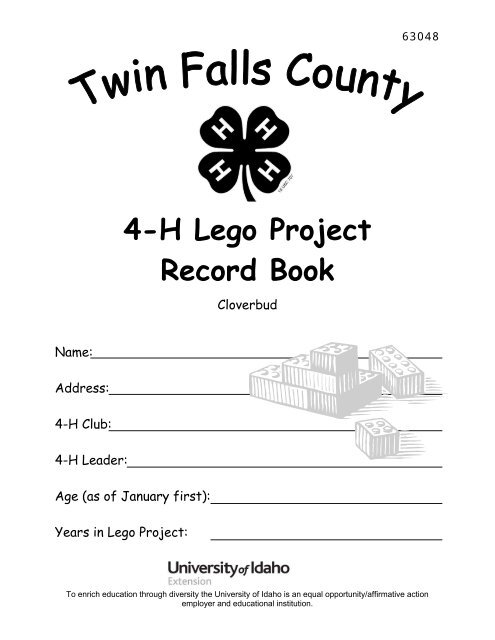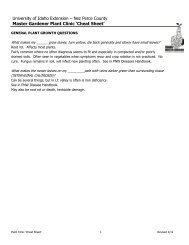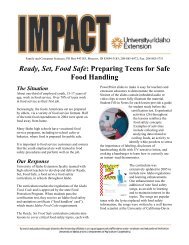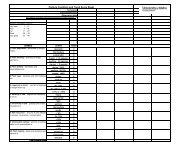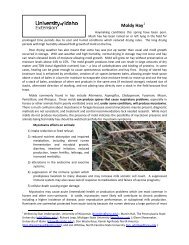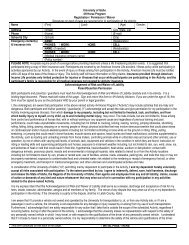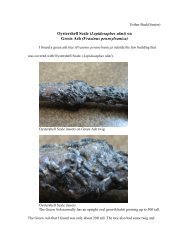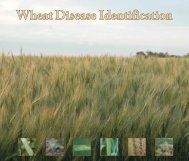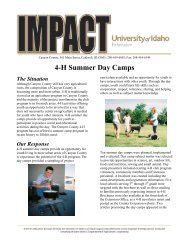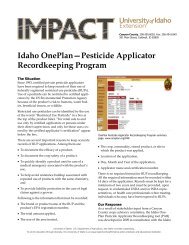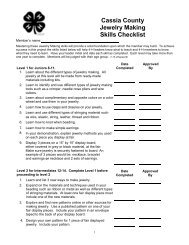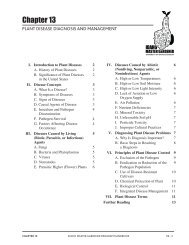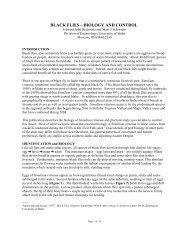4-H Lego Project Record Book - University of Idaho Extension
4-H Lego Project Record Book - University of Idaho Extension
4-H Lego Project Record Book - University of Idaho Extension
You also want an ePaper? Increase the reach of your titles
YUMPU automatically turns print PDFs into web optimized ePapers that Google loves.
Name:<br />
Address:<br />
4-H Club:<br />
4-H Leader:<br />
4-H <strong>Lego</strong> <strong>Project</strong><br />
Age (as <strong>of</strong> January first):<br />
Years in <strong>Lego</strong> <strong>Project</strong>:<br />
<strong>Record</strong> <strong>Book</strong><br />
Cloverbud<br />
63048<br />
To enrich education through diversity the <strong>University</strong> <strong>of</strong> <strong>Idaho</strong> is an equal opportunity/affirmative action<br />
employer and educational institution.
The 4-H Emblem is:<br />
A green four-leaf clover with the<br />
letter “H” on each leaf is the<br />
emblem. Each “H” stands for a<br />
part <strong>of</strong> the pledge -<br />
Head,<br />
Heart,<br />
Hands,<br />
Health<br />
The 4-H Colors are:<br />
Green and White.<br />
Green symbolizes nature’s most common color.<br />
White symbolizes purity.<br />
The 4-H Motto is:<br />
“To Make The Best Better”<br />
This motto challenges everyone involved in 4-H to<br />
do the very best job they can.<br />
2
Flag Pledges<br />
The American Flag Pledge:<br />
“I pledge allegiance to the flag <strong>of</strong> the United States <strong>of</strong><br />
America, and to the republic for which is stands, one nation<br />
under God, indivisible, with liberty and justice for all.”<br />
(When repeating the pledge, your right hand should be placed over your heart<br />
which is on the left side.)<br />
The National 4-H Pledge:<br />
I Pledge:<br />
My Head to clearer thinking<br />
My Heart to Greater loyalty<br />
My Hands to larger service, and<br />
My Health to better living for my club,<br />
my community, my country, and my world.<br />
3
Twin Falls County 4-H Cloverbuds<br />
���Discover new strengths and talents.<br />
���Learn cooperation.<br />
���Practice making good choices.<br />
���Strengthen the family unit.<br />
���Gain confidence and self-reliance.<br />
Things to Remember<br />
My Club Leader’s Name<br />
My Club Leader’s Phone #<br />
My Meeting Time<br />
My Meeting Place<br />
4<br />
4-H<br />
Cloverbuds
Name:<br />
Cloverbud <strong>Project</strong> <strong>Record</strong><br />
This is my ______ year in Cloverbuds.<br />
We had ______ Cloverbud meetings/trips.<br />
I went to ______ <strong>of</strong> these Cloverbud meetings/trips.<br />
I went to ______ regular 4-H club meetings.<br />
What did you take to the fair? (list)<br />
_________________________________________<br />
_________________________________________<br />
_________________________________________<br />
Parent/Guardian Comments:<br />
_________________________________________<br />
_________________________________________<br />
_________________________________________<br />
Parent/Guardian Signature: ____________________<br />
Date: ___________<br />
5
NOTE:<br />
Objectives <strong>of</strong> the 4-H Cloverbud<br />
<strong>Lego</strong> <strong>Project</strong><br />
1. To gain experience creating and designing with <strong>Lego</strong>s.<br />
2. To explore and use your imagination with building<br />
materials.<br />
3. To participate in group activities within your 4-H club.<br />
��Cloverbud projects are for the child to explore and<br />
discover project areas.<br />
��Cloverbud projects are not to be judged or placed in<br />
any 4-H activity.<br />
��Safety <strong>of</strong> the child should be the primary concern<br />
<strong>of</strong> the cloverbud project.<br />
6
7<br />
<strong>Lego</strong><br />
Word Search<br />
L E A R N T P Z K C Y B<br />
F Q C L Q D L E G O I L<br />
C A X S A E O X L N O O<br />
O Z Z N S S U C A N P C<br />
N W P A D I I S S E A K<br />
S S L P F G Y V E C S S<br />
T X M M G N B B D T D Q<br />
R E O B H R U N F F S W<br />
U D I M A G I N E G P E<br />
C C K N J E L M G H L R<br />
T R I V K W D L H J A T<br />
V C R E A T I V I T Y U<br />
LEGO<br />
DESIGN<br />
PLAY<br />
CREATIVITY<br />
BLOCKS<br />
SNAP<br />
CONSTRUCT<br />
IMAGINE<br />
CONNECT<br />
SETS<br />
BUILD<br />
LEARN
Bug House<br />
It is very interesting to investigate pet animals and their way <strong>of</strong> life.<br />
However, a jar is not a good place to keep a pet insect.<br />
It needs shelter, food and water in order to survive – and it wants to have fun.<br />
Construct<br />
Design and make a wonderful bug house that:<br />
�� is easy to see into<br />
�� has safe hiding places that bugs would like to use<br />
�� does not let the bugs escape<br />
�� provides plenty <strong>of</strong> air, water and food.<br />
Contemplate<br />
Snails, beetles and caterpillars (herbivores) are easier to keep than spiders, ants or centipedes.<br />
Is there plenty <strong>of</strong> air? Check and see. Can the bugs get out <strong>of</strong> the bug house? Put the bug<br />
houses with their bugs in a big plastic tub. Check from time to time to see if there are any<br />
escapees in the tub. Do the bugs like their hiding places? See what happens if you shine a<br />
bright light into the bug house. Are they eating the food you have given them? Put the food in a<br />
clean dish. Leave the dish overnight and then check to see what the bugs have eaten. Leave the<br />
dish during the day and check again. What did you discover? (With the help <strong>of</strong> an adult, write<br />
down what you learned from the project in the Story section below.)<br />
Continue<br />
● Invent a brand new block "bug". Name it and tell what it does.<br />
● Turn your bug house into a bug catcher. Leave it in an outdoor garden overnight. In the<br />
morning see which bugs have moved in!<br />
● Investigate the many unusual homes that insects live in.<br />
Learning Values Suggested Materials<br />
Animals have needs 9090 XL DUPLO Bulk Set<br />
Ventilation and light Either real or pretend insects<br />
Secure structures Plastic wrapping<br />
Animal behavior Small dishes to hold water and food<br />
Soil<br />
Story: _______________________________________________________________________<br />
_____________________________________________________________________________<br />
_____________________________________________________________________________<br />
_____________________________________________________________________________<br />
_____________________________________________________________________________<br />
_____________________________________________________________________________<br />
_____________________________________________________________________________<br />
_____________________________________________________________________________<br />
8
Ro<strong>of</strong>top Gardens<br />
Most big cities have tall buildings with apartments for people to live in. Unfortunately, not every<br />
family can have a garden <strong>of</strong> their own, so you <strong>of</strong>ten find a garden on top <strong>of</strong> the building instead.<br />
Getting there may be a bit dangerous, especially when using a ladder and carrying things like<br />
plants and shovels, etc.<br />
Construct<br />
Design and make safe outside steps leading up to the ro<strong>of</strong>top garden. The ro<strong>of</strong>top should:<br />
�� be at least 5 Duplo people high<br />
�� have steps that go up one step at a time – and are as safe as possible<br />
�� include a device to lift up heavy things for the ro<strong>of</strong>top garden.<br />
Contemplate<br />
How high up is the ro<strong>of</strong>top? Measure its height with a Duplo person. Can you use a different<br />
measuring device? Try using a piece <strong>of</strong> string, a ruler or a strip <strong>of</strong> paper. Do the steps go up one<br />
at a time? Check the top steps especially. These can be hard to get right. How safe are the<br />
steps? Check to see if the person climbing the steps can fall <strong>of</strong>f the side at any point. Railings or<br />
ropes on the open sides <strong>of</strong> the steps would help a lot. Are the steps strong and stable? The<br />
stronger and more stable, the better. How does your device to lift up the tools work? Try using<br />
some sort <strong>of</strong> pulley system and string. (With the help <strong>of</strong> an adult, write down what you learned<br />
from the project in the Story section below.)<br />
Continue<br />
● Build a set <strong>of</strong> safe steps on wheels.<br />
● Make it possible to use the same set <strong>of</strong> moveable steps on two ro<strong>of</strong>tops with different heights.<br />
● Steps are a real problem for people in wheelchairs. How do builders make it possible for<br />
people in wheelchairs to move around in new buildings?<br />
Learning Values Suggested Materials<br />
Stable structures, forces 9027 LEGO® DUPLO® Bulk Set<br />
Measuring 9089 Tubes Experiment Set<br />
Testing functionality String, wool, straws to make safe railings<br />
Garden materials.<br />
Story: _______________________________________________________________________<br />
_____________________________________________________________________________<br />
_____________________________________________________________________________<br />
_____________________________________________________________________________<br />
_____________________________________________________________________________<br />
_____________________________________________________________________________<br />
_____________________________________________________________________________<br />
_____________________________________________________________________________<br />
9
Maze<br />
Attach the pieces<br />
10
SUSHI<br />
Use Your Imagination!<br />
Use your imagination to build buildings, cars, animals, food, household items, etc.<br />
Do NOT use a kit or predesigned building set or design manual.<br />
List 4 things you want to try and make<br />
1. ___________________________________<br />
2. ___________________________________<br />
3. ___________________________________<br />
4. ___________________________________<br />
PENCIL<br />
LEGO TOWN<br />
11<br />
AIRPLANE<br />
What worked?____________________________________________________________<br />
_______________________________________________________________________<br />
What didn’t? _____________________________________________________________<br />
Why? __________________________________________________________________<br />
_______________________________________________________________________<br />
There is no doubt about it, <strong>Lego</strong> Kits can be fun, but look at some <strong>of</strong> the neat stuff people<br />
have made just by using their imaginations!<br />
WAFFLE<br />
HAMBURGER<br />
DRINK & FRIES
Lion Cub Playground<br />
Leo and Lucy the lion cubs are very active and love to play. That is actually how they learn the<br />
lion’s way <strong>of</strong> life. They need plenty <strong>of</strong> interesting activities to give them exercise and challenges,<br />
and to keep them occupied.<br />
Construct<br />
Design and make an interesting and fun playground for the lion cubs. It should:<br />
�� Allow the cubs to practice climbing and balancing<br />
�� include swings<br />
�� include high platforms for the cubs to practice jumping from.<br />
Contemplate<br />
How many different things are there for Leo and Lucy to do? Count and see. How many lion cubs<br />
can use the playground at the same time? The more the better. Are there some easy and safe<br />
activities for the youngest lion cubs? Even though lion cubs have a natural ability to climb, jump<br />
and attack, they need to be able to practice at different levels <strong>of</strong> difficulty. Are there some really<br />
difficult activities for the more experienced lion cubs? If not, make some. The more exciting and<br />
challenging the better. Lion cubs like to climb high. How high can Leo and Lucy actually climb?<br />
Use some sort <strong>of</strong> measuring device to see how high the platforms are. Are they still safe to climb,<br />
or do you need to stabilize them in some way? What distance can the lion cubs climb without<br />
going over the same challenges twice? (With the help <strong>of</strong> an adult, write down what you learned<br />
from the project in the Story section below.)<br />
Continue<br />
● Rebuild or improve your playground to include the longest “Obstacle Course” possible where<br />
the cubs do not have to touch the ground.<br />
● Where do wild lion cubs live? Find out about what they eat, how they live and the enemies<br />
they have.<br />
tures<br />
Learning Values Suggested Materials<br />
Taking care <strong>of</strong> animal needs 9660 DUPLO Early Struc-<br />
Safety and recreation 9089 Tubes Experiment Set<br />
Designing challenges with a purpose String & twigs<br />
Testing functionality S<strong>of</strong>t landing materials<br />
Story: _______________________________________________________________________<br />
_____________________________________________________________________________<br />
_____________________________________________________________________________<br />
_____________________________________________________________________________<br />
_____________________________________________________________________________<br />
_____________________________________________________________________________<br />
_____________________________________________________________________________<br />
_____________________________________________________________________________<br />
12
Maze Game<br />
Have you ever played a maze game, where you hold a little maze in your hand and try to<br />
make the ball roll from the one end to the other? Here is a new maze game that you can<br />
build yourself – and that’s in 3D too!<br />
Construct<br />
● Build a wall around the edge <strong>of</strong> a big building plate.<br />
● Decide where the game is going to start and how to get the ball rolling (use the tubes and put<br />
them into a tower).<br />
● Build some obstacles for the ball to roll around or through.<br />
● Hold the base plate and roll the ball around – see if you can make it go slowly – can you make<br />
it go fast?<br />
Contemplate<br />
Where did you make the game start and end? Can the ball roll uphill? What happens if the tube<br />
turns up at the end? Does it slow the ball down? Is it better to roll the ball quickly or slowly? Can<br />
you make it speed up or slow down? (With the help <strong>of</strong> an adult, write down what you learned<br />
from the project in the Story section below.)<br />
Continue<br />
● Try making a scoring system – the difficult obstacles should have a higher score than the<br />
easy ones.<br />
● Add flags or numbers to show the score, so that the players can keep track <strong>of</strong> their points.<br />
● Try making a tunnel out <strong>of</strong> DUPLO bricks or a bent piece <strong>of</strong> cardboard.<br />
13<br />
Learning Values Suggested Materials<br />
Creating and controlling movement 9089 Tubes Experiment Set<br />
Investigating gravity 9071 Large DUPLO® Building Plates<br />
Observing cause and effect in action Paper, crayons, cardboard<br />
Improving eye-hand co-ordination<br />
Story: _______________________________________________________________________<br />
_____________________________________________________________________________<br />
_____________________________________________________________________________<br />
_____________________________________________________________________________<br />
_____________________________________________________________________________<br />
_____________________________________________________________________________<br />
_____________________________________________________________________________<br />
_____________________________________________________________________________
Color The Construction Kids<br />
14
Holiday At The Farm<br />
People who live in big cities <strong>of</strong>ten like to spend their holidays on a farm. It’s great to experience<br />
life on the farm – and especially fascinating to visit the stables and see how farm work is done.<br />
The MacDonald family would like to build a place where they can have guests to stay.<br />
Construct<br />
Design and make a special holiday house at the MacDonald farm for six visitors to stay in. It<br />
should:<br />
�� have at least three bedrooms<br />
�� have space for the whole family to have meals together<br />
�� connect to the farmhouse so that visitors can move from one building to the other without<br />
getting wet.<br />
Contemplate<br />
Does the holiday house have at least three bedrooms? Are the rooms big enough for at least two<br />
visitors to sleep in? Check to see. Have you considered whether the house can accommodate<br />
disabled people, e.g. in a wheelchair? How would they get around? Wheel a chair around in the<br />
farmhouse and find out what the problems are. Find a way to solve them. Is there a way to<br />
connect the holiday house to the farmhouse? It should be covered. Test to see if it works.<br />
Sprinkle in water to see if you can walk through without getting wet. What other facilities will<br />
visitors need in the house? Find two more things and add them to your building. Why would<br />
people who live in cities like to spend their holidays on a farm? Do farmers get holidays? Where<br />
would they like to spend their holidays? (With the help <strong>of</strong> an adult, write down what you learned<br />
from the project in the Story section below.)<br />
Continue<br />
● Design and make a garden for the house to make it look real nice.<br />
● Construct a way to protect the garden from the farm animals.<br />
Learning Values Suggested Materials<br />
Finding out how buildings work and 9227 Farm Set<br />
testing functionality (logic) String, straws, cloth (for bedding)<br />
Considering other people's needs waterpro<strong>of</strong> material for the ro<strong>of</strong><br />
garden materials<br />
Story: _______________________________________________________________________<br />
_____________________________________________________________________________<br />
_____________________________________________________________________________<br />
_____________________________________________________________________________<br />
_____________________________________________________________________________<br />
_____________________________________________________________________________<br />
_____________________________________________________________________________<br />
_____________________________________________________________________________<br />
15
Holiday Village<br />
People love to go on holiday in Stiltsville. All the houses are on stilts, and the children can just<br />
slide down these to go outside and play. Beneath the houses there are swings that the children<br />
play on all day long!<br />
Construct<br />
● Think about where you would like to go on holiday – and then build your imaginary<br />
holiday house on stilts.<br />
● Use your model to make up stories about people who go on holiday in your holiday village!<br />
Contemplate<br />
How do people get from one end <strong>of</strong> your holiday village to the other? Is there something for<br />
children <strong>of</strong> all ages to do? What kind <strong>of</strong> things would you like to do when you get there? Think up<br />
a good name for your holiday village. (With the help <strong>of</strong> an adult, write down what you learned<br />
from the project in the Story section below.)<br />
Continue<br />
● Make a poster showing your holiday village.<br />
● Try making the thing you like most about your village really big on the poster.<br />
● Draw smaller pictures <strong>of</strong> other things to see and do there around the edge <strong>of</strong> your poster.<br />
Learning Values Suggested Materials<br />
Language and non-verbal communication 9302 Community Builders Set<br />
The ability to mirror the world through creative play 9306 Bulk Set with Special Bricks<br />
Using imagination to create new stories and events Large sheet <strong>of</strong> paper, crayons or paint<br />
Pebbles for the seaside<br />
Story: _________________________________________<br />
_______________________________________________<br />
_______________________________________________<br />
_______________________________________________<br />
_______________________________________________<br />
_______________________________________________<br />
_______________________________________________<br />
_______________________________________________<br />
_______________________________________________<br />
_______________________________________________<br />
_______________________________________________<br />
16
World Village<br />
The town has been chosen to host the next big games! There were stadiums and swimming<br />
pools to build, and a whole new village to create where the athletes would live. People from all<br />
over the world would be arriving. The people would need to feel safe. The emergency services<br />
had to think about the big crowds and how to reach people quickly. So much to do – and so little<br />
time! Can you help the people <strong>of</strong> the town to get ready for the games?<br />
Construct<br />
● Build some houses for the athletes to live in.<br />
● The athletes and visitors will need somewhere to eat. Build a café and restaurant.<br />
Contemplate<br />
The big games are an international event, so there will be all different types <strong>of</strong> food needed. Can<br />
you name some <strong>of</strong> them? When people have been eating there is <strong>of</strong>ten a lot <strong>of</strong> rubbish. Make<br />
sure your village encourages people to keep it clean and recycle cans, glass and paper rubbish.<br />
How will you manage? (With the help <strong>of</strong> an adult, write down what you learned from the project in<br />
the Story section below.)<br />
Continue<br />
● How will people find their way around the village? Make some signs that show the people<br />
where the different buildings are.<br />
● If there is an emergency, the emergency services may need to get in and out quickly – make<br />
sure your village is a safe place to be.<br />
● The opening ceremony is always a really special event. Organize the opening party with<br />
decorations and a spectacular light show!<br />
Learning Values Suggested Materials<br />
Developing social awareness 9247 Community Workers Set<br />
Interaction with people from different cultures 9302 Community Builders Set<br />
Appreciating the roles <strong>of</strong> different community workers 9224 Community People Set<br />
Paper and crayons for signs, string<br />
Story: _______________________________________________________________________<br />
_____________________________________________________________________________<br />
_____________________________________________________________________________<br />
_____________________________________________________________________________<br />
_____________________________________________________________________________<br />
_____________________________________________________________________________<br />
_____________________________________________________________________________<br />
_____________________________________________________________________________<br />
17
<strong>Project</strong> Story<br />
With the help <strong>of</strong> your leader, teen leader, parent or adult helper,<br />
answer the following questions about your project.<br />
1. The most important thing I learned was: _____________<br />
_________________________________________<br />
_________________________________________<br />
_________________________________________<br />
2. Things I want to learn more about are: ______________<br />
_________________________________________<br />
_________________________________________<br />
_________________________________________<br />
3. Mark which <strong>Lego</strong> projects you did.<br />
__ Bug House __ Holiday at The Farm<br />
__ Ro<strong>of</strong>top Gardens __ Holiday Village<br />
__ Lion Cub Playground __ World Village<br />
__ Maze Game __ Use Your Imagination<br />
4. Did you finish all <strong>of</strong> the <strong>Lego</strong> projects you started? ______<br />
5. List all the <strong>Lego</strong> projects you started but didn’t finish and why.<br />
_________________________________________<br />
_________________________________________<br />
_________________________________________<br />
_________________________________________<br />
18
Photos<br />
Photos <strong>of</strong> your different <strong>Lego</strong> projects can be<br />
attached to this page.<br />
19
Information adapted from Adams County, Colorado State<br />
<strong>University</strong> <strong>Extension</strong>, and various other sources.<br />
<strong>Project</strong> ideas from www.lego.com<br />
The <strong>University</strong> <strong>of</strong> <strong>Idaho</strong> provides equal opportunity in education and employment on the basis <strong>of</strong> race, color, religion, national<br />
origin, gender, age, disability, or status as a Vietnam-era veteran, as required by state and federal laws.<br />
20


